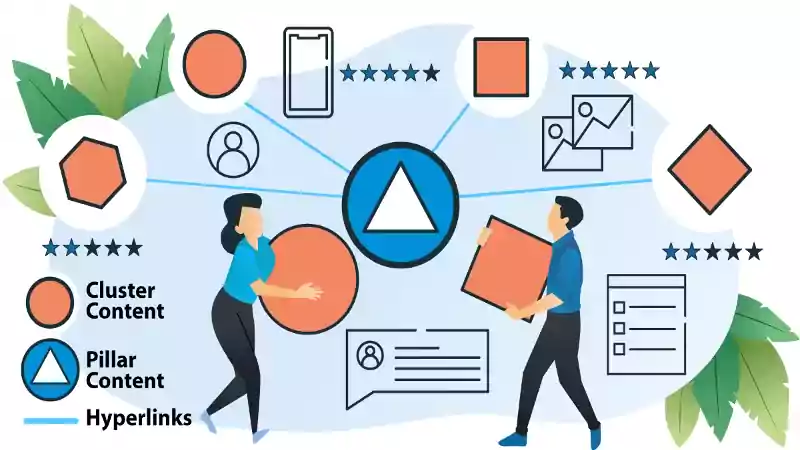How to Use Topic Clusters to Outrank Competitors

Are you struggling to climb the search engine ranks while competitors dominate? In the complex world of B2B, visibility isn’t just a luxury—it’s a necessity. Are you creating a wealth of content yet seeing minimal impact on your search engine ranking? Imagine a strategy that not only organizes your content for clarity but also signals to search engines that you’re an authority in your field.
This isn’t just about keywords; it’s about creating a network of information that elevates your entire online presence. Let’s explore how to transform your SEO approach and outrank your competitors.
The B2B digital landscape is a relentless arena. Companies face the constant challenge of cutting through the noise, reaching decision-makers who are often buried under a mountain of information. Unlike consumer searches, B2B queries are typically complex, requiring in-depth, authoritative content. This necessitates a strategic approach that goes beyond simple keyword stuffing. That’s where topic clusters come into play.
What are Topic Clusters?
Topic clusters are a powerful SEO strategy that organizes your content into interconnected hubs, signaling to search engines the depth and breadth of your expertise. At their heart, topic clusters are a strategic organization of your website’s content centered around a single pillar page.
Think of the pillar page as a comprehensive guide to a broad topic, while supporting content—blog posts, case studies, or white papers—delves into specific subtopics. This structure creates a network of interconnected content, signaling to search engines the depth of your expertise.
Content hubs play a pivotal role in this structure. They act as the central organizing point, ensuring that all related content is easily accessible and logically connected. This not only enhances user experience but also allows search engines to efficiently crawl and understand your site’s architecture. By creating a clear hierarchy of content, you guide both users and search engines through a seamless journey of discovery.
The benefits of topic clusters for B2B SEO are manifold. For starters, they significantly improve site architecture. A well-organized site is easier for search engines to crawl and index, leading to better visibility. As Search Engine Journal reports, topic clusters can increase user time on site by 20%, indicating higher engagement and relevance.
Moreover, topic clusters directly contribute to improved search engine ranking. Internal linking within a cluster distributes authority and strengthens the overall relevance of each page. When you link supporting content back to the pillar page, you create a network of authority, signaling to search engines that your content is comprehensive and valuable. This strategic interlinking helps elevate the ranking of all pages within the cluster, establishing your brand as a thought leader in your industry.
Identifying Core Topics and Supporting Content
Target Audience and Search Intent
Identifying the right core topics and supporting content is crucial for building effective topic clusters. It starts with a deep understanding of your target audience’s search intent. In the B2B world, this often means catering to complex buying journeys. Decision-makers aren’t just looking for quick answers; they seek in-depth, authoritative information that can guide strategic decisions. Therefore, your content must be informative, detailed, and relevant to their specific needs.
Keyword Research
Keyword research plays a pivotal role in identifying these core topics. Tools like Ahrefs and SEMrush can help you uncover high-volume, relevant keywords that your target audience is actively searching for. By analyzing search volume, keyword difficulty, and related queries, you can pinpoint topics that align with your audience’s interests and needs. For instance, instead of targeting broad terms like “cloud computing,” you might focus on more specific phrases and long-tail keywords like “cloud migration strategies for enterprise” or “cost optimization with cloud services.”
Supporting Content
Identifying supporting content opportunities involves looking beyond primary keywords. “People also ask” sections and related searches on search engine results pages can provide valuable insights into subtopics and frequently asked questions. These can serve as starting points for creating supporting content that addresses specific pain points and provides comprehensive answers. As Moz points out, long-tail keywords account for a majority of all search queries. This highlights the importance of targeting niche topics that cater to specific segments of your audience.
The Buyer’s Journey
Aligning content with the B2B buyer’s journey is another critical aspect. Your content should guide potential customers through each stage of their decision-making process.
-
For awareness-stage content, focus on educational materials that introduce core concepts and highlight industry trends. This could include blog posts, white papers, or infographics that provide general information.
-
Consideration-stage content should delve deeper into specific solutions and their benefits. Case studies, product comparisons, and webinars can help potential customers evaluate their options.
-
Finally, decision-stage content should focus on providing concrete information that supports the final purchasing decision. This could include demos, free trials, and detailed product specifications.
By creating content that aligns with each stage of the buyer’s journey, you can effectively guide potential customers toward a purchase.
Building and Interlinking Topic Clusters
Create a Pillar Page
Building effective topic clusters requires a strategic and methodical approach. First, creating a robust pillar page is essential. This page should serve as the cornerstone of your cluster, covering a broad core topic comprehensively. Think of it as the go-to resource for everything related to that subject. For instance, if your core topic is “Enterprise Cybersecurity,” your pillar page should cover all aspects, from threat detection and prevention to compliance and risk management. This page needs to be authoritative, well-researched, and structured to provide a clear overview, encouraging readers to explore deeper into the subtopics.
Develop Supporting Content
Next, develop supporting content that dives into specific subtopics. This content should complement your pillar page, providing detailed insights and addressing specific pain points. For example, you could create blog posts on “Advanced Persistent Threats in Healthcare,” case studies on “Successful Cybersecurity Implementation for Financial Institutions,” or white papers on “The Role of AI in Cybersecurity.” Each piece of supporting content should be meticulously crafted to provide value and establish your expertise in the respective subtopic.
Interlink Content
Strategic interlinking is crucial for connecting your pillar page and supporting content. Use relevant anchor text to link between pages, creating a seamless navigation experience. For example, within your “Enterprise Cybersecurity” pillar page, you could link to your “Advanced Persistent Threats in Healthcare” blog post using anchor text like “healthcare cybersecurity challenges.” This guides users to relevant content and signals to search engines the relationship between your pages. As stated, internal links help search engines understand the structure of your website and the relationships between your pages, which can improve your overall SEO performance.
Track and Measure Performance
Finally, tracking and measuring the performance of your topic clusters is vital for ongoing optimization. Use tools like Google Analytics and Google Search Console to monitor key metrics such as organic traffic, keyword rankings, and user engagement. Analyze which pages are performing well and identify areas for improvement. For instance, if you notice a high bounce rate on a particular supporting content page, you might need to revise the content or improve its relevance to the pillar page. Regularly monitoring these metrics allows you to refine your topic cluster strategy and ensure it continues to drive results.
Beyond tracking and measuring, the ongoing maintenance and optimization of your topic clusters are crucial for sustained success.
Regular Content Updates:
Algorithm Monitoring:
Cluster Expansion:
Digital Dominance: The Topic Cluster Blueprint
You’ve navigated the complexities of topic clusters, understanding their power to transform your B2B SEO. This isn’t about chasing fleeting keyword trends; it’s about building a structured, authoritative network that positions your brand as the definitive source of information. It’s about creating an ecosystem where your content works in unison, driving qualified leads through their entire buying journey.
The reality is, B2B search dominance isn’t achieved through haphazard content creation. It requires a meticulous, data-driven strategy that aligns with the sophisticated needs of your audience. If you’re ready to move beyond basic SEO and construct a digital presence that delivers tangible results, Aspiration Marketing is here to guide you. We specialize in developing and implementing advanced topic cluster strategies that elevate your brand and secure your competitive advantage.
Let’s collaborate to build your authority and drive sustainable growth.









Responses